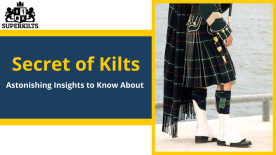Kilts, renowned for their tartan patterns and deep-rooted history, are a quintessential emblem of Scottish culture. These garments, far more than just traditional attire, embody a rich tapestry of history, symbolism, and pride. Originating from the rugged Highlands, kilts have journeyed through time, evolving from simple plaids to sophisticated symbols of identity and heritage.
This article aims to explore beyond the secrets of kilts, revealing 11 lesser-known facets of their intriguing history. We will delve into the origins, cultural significance, and evolving role of kilts in both traditional and contemporary contexts, uncovering the layers of mystery and tradition that have cemented their status as iconic symbols of Scotland.
1. Kilts Have a Military Background

Kilts, as we recognize them today, have their roots deeply embedded in Scottish military history. During the early 18th century, kilts were adopted as a part of the uniform for Highland regiments. This was not merely a cultural or aesthetic choice; the kilt's design provided practical benefits.
Its structure allowed for remarkable freedom of movement, essential for soldiers navigating the Scottish Highlands' challenging and often rugged terrain. The kilt's adaptability to various weather conditions also added to its appeal as military attire.
Over time, the military kilt evolved, becoming a symbol of Scottish bravery and skill in warfare and, later, an integral part of Scotland’s national identity.
2. Not All Kilts Are Tartan
While tartan is synonymous with the traditional Scottish kilt, this pattern is not a universal feature of all kilts. Solid-colored affordable kilts are emerging alongside the classic tartan variety, frequently referred to as "utility kilts." These kilts, devoid of the tartan's crisscross patterns, offer a contemporary, versatile twist to the age-old garment. They are increasingly popular for everyday use and are favored in certain professions and activities that require durable and functional attire. The utility kilt’s simplicity and practicality make it a modern alternative, expanding the kilt's reach beyond ceremonial occasions to more casual, everyday environments.
3. Kilts Once Faced a Ban

In a dramatic chapter of Scottish history, the kilt became a symbol of defiance following its ban in 1746. This prohibition by the British government was intended to suppress the rebellious spirit of the Highlanders following the Jacobite risings.
By outlawing this deeply symbolic garment, the authorities aimed to erode the cultural identity that the kilt represented. However, the ban, which lasted almost 40 years, inadvertently elevated the kilt to a symbol of resistance and Scottish nationalism. When the ban was finally lifted, the men's kilts re-emerged as a cultural attire and a powerful emblem of Scottish pride and resilience.
4. The Art of Kilt Making
Creating a kilt is an art form that combines tradition with meticulous craftsmanship. Approximately 8 yards of fabric are used in constructing a single kilt. This fabric is not merely cut and sewn; it involves a detailed process of hand-pleating, where each fold is carefully measured and stitched to achieve the garment's signature look.
The precision involved in the kilt's construction is a testament to the skill of the kiltmaker, a craftsperson who upholds centuries-old techniques. This process ensures that each kilt is a piece of clothing and a work of art, rich in cultural heritage and individual craftsmanship. Kilts for women and men are made with equal precision.
5. Kilts in Women's Fashion

Kilts transcended gender boundaries in the 19th century, integrating into women's fashion, a movement significantly influenced by Queen Victoria's admiration for Scotland. This royal endorsement led to the adaptation of the traditional kilt into kilted skirts for women.
Unlike the traditional male kilt, women's kilts adapted to changing fashion trends, evolving in length and style over time. Initially, these skirts were a direct nod to Scottish heritage, incorporating tartan patterns and resembling their male counterparts in design. However, as fashion progressed, women's kilts began to embrace a broader range of fabrics, colors, and patterns, moving beyond the classic tartan.
Today, these garments strike a balance between traditional Scottish attire and modern fashion sensibilities. They are often seen in casual and formal settings, offering versatility and a unique style statement. Women's kilts have become an emblem of cultural pride, fashion-forward thinking, and a celebration of Scottish heritage, resonating with a wide range of age groups and fashion preferences.
6. The Sporran's Practicality
The sporran, an essential accessory of the kilt, is rooted in practicality. Originating from a time when kilts lacked pockets, the sporran served a vital function as a storage space for personal items. It is typically a pouch made of leather or fur, hanging just in front of the kilt.
The design of the sporran varies widely, from simple and unadorned for everyday use to elaborate and ornate versions for formal occasions. The practical aspect of the sporran has always been its core function, but over time, it has evolved into a significant fashion element of the kilt ensemble.
Sporrans are often elaborately decorated in formal settings with Celtic designs and tassels and sometimes incorporate symbols representing the wearer's clan or family heritage. The sporran not only complements the aesthetic of the kilt but also continues to serve as a practical component, blending functionality with cultural symbolism and fashion.
7. Kilts in Formal Occasions

Kilts are prestigious in Scottish formal attire, often worn at events such as weddings, official ceremonies, and cultural celebrations. In these settings, the kilt is more than just a garment; it is a display of heritage, family lineage, and personal identity.
The choice of tartan in these instances can be particularly meaningful, with many opting to wear the tartan pattern associated with their family name or region. The formal kilt outfit typically includes a tailored jacket, such as Prince Charlie or Argyll, and is accessorized with a sporran, kilt hose, and ghillie brogues.
In addition to the traditional components, personal touches like clan badges, kilt pins, and cufflinks are often added, making each kilt outfit uniquely personal. Wearing a kilt at formal occasions is a powerful way to connect with Scottish heritage, and it is embraced not only by Scots but also by people of Scottish descent worldwide. In these formal settings, the kilt transcends its role as mere attire, becoming a symbol of pride, respect for tradition, and a celebration of Scottish culture.
8. The Global Spread of Kilts
Once a symbol of Scottish identity, the kilt has crossed national boundaries to become a global fashion phenomenon. Its spread beyond Scotland is a testament to the universal appeal of this unique garment.
Today, kilts are celebrated and worn in various countries worldwide, particularly at Celtic festivals, which honor and preserve the heritage of Celtic nations. These festivals, often featuring music, dance, and traditional crafts, have become hubs for the display of kilts in their myriad forms.
Adopting the kilt in countries with the Scottish diaspora, like the United States, Canada, and Australia, has played a significant role in its international popularity. Here, it's not just a piece of clothing but a symbol of ancestral pride and a way to connect with one's roots. Additionally, the kilt has been embraced by people with no direct Scottish ancestry, attracted by its unique style and cultural resonance.
Designers have incorporated kilt designs into mainstream fashion, further enhancing its global appeal. This widespread popularity of the kilt demonstrates its versatility and timelessness, transcending cultural and geographical boundaries to become a truly global icon.
9. The Significance of Tartan Patterns

Tartan patterns are much more than just decorative elements of the Scottish kilt; they are deeply imbued with historical and familial significance. Each tartan pattern is unique and often represents a particular Scottish clan, family, or region. This tradition dates back centuries, with specific patterns and colors indicating allegiance to a certain clan or geographical area.
Choosing a tartan, therefore, can be a deeply personal decision, reflecting one's lineage, heritage, or connection to a specific Scottish clan. For those of Scottish descent, wearing the tartan of their ancestors is a way to honor their heritage and feel a connection to their family's history.
In contemporary times, the significance of tartan patterns has expanded. New tartans are being created to represent various institutions, organizations, and even modern families, making the tradition more inclusive and adaptable to the changing times. The diversity and significance of tartan patterns add a profound layer of meaning to the kilt, transforming it from a mere garment into a symbol of identity and belonging.
10. Kilts in Sports and Athletics
The kilt has made a unique foray into the world of sports and athletics, particularly in Scottish traditional games. In events like the Highland Games, which celebrate Scottish and Celtic culture, the kilt is more than just attire; it's a symbol of cultural identity and heritage.
Athletes competing in traditional Scottish events such as the caber toss, hammer throw, and tug of war often wear kilts, adding a distinctive Scottish flair to these competitions. The kilt's functionality and ease of movement make it well-suited for these athletic endeavors. This tradition not only keeps the spirit of the kilt alive but also adds an element of spectacle and cultural significance to these sports.
Wearing a kilt in these athletic contexts is a nod to history and tradition, bridging the past with the present. It's a way for athletes to pay homage to their heritage while engaging in the sports they love. The presence of the kilt in sports underscores its versatility and enduring appeal, proving that it's not just a ceremonial or formal garment but a living, adaptable symbol of Scottish culture.
11. Kilts and Modern Fashion

In the realm of modern fashion, the kilt has emerged as a symbol of sartorial innovation, seamlessly blending traditional Scottish heritage with contemporary style. Fashion designers, drawn to its unique silhouette and rich cultural background, have reimagined the kilt in diverse and creative ways. This integration into mainstream fashion has propelled the kilt beyond its conventional boundaries, introducing it to a broader fashion-forward audience.
The modern reinterpretation of the kilt often involves experimenting with fabrics, colors, and patterns that diverge from the classic tartan. Designers have created kilts in denim, leather, and even synthetic materials, catering to a variety of tastes and occasions. The traditional pleats and kilt length are frequently modified, giving rise to mini-kilts, hybrid kilt-trousers, and even avant-garde kilt-inspired dresses.
The adaptability of the kilt in high fashion has also seen it transcend gender norms. What was once primarily a male garment in Scotland has been embraced by people of all genders and celebrated for its versatility and statement-making potential. The kilt's inclusion in fashion shows and celebrity wardrobes has further cemented its status as a contemporary fashion staple.
This fusion of tradition and modernity in kilt design highlights the garment's timeless appeal and signifies a broader fashion trend that values cultural heritage while embracing change and innovation. The kilt's journey into modern fashion showcases its enduring relevance and its ability to adapt and thrive in a constantly evolving fashion landscape.
FAQs:
1. What is the historical significance of the kilt?
The kilt is a traditional Scottish garment with deep historical roots, primarily associated with the Scottish Highlands. It became a symbol of Scottish national identity, especially following its use in the military and its subsequent ban in the 18th century, which fueled its significance as a symbol of resistance and cultural pride.
2. Are kilts still popular in Scotland today?
Yes, kilts remain popular in Scotland, not just as a symbol of heritage but also as a contemporary fashion item. They are commonly worn at formal events like weddings, cultural celebrations, and Highland games, as well as for everyday wear by those embracing traditional styles.
3. Can kilts be worn for everyday activities?
Absolutely. While traditionally associated with formal or ceremonial occasions, kilts have evolved into versatile garments. Utility kilts, for example, are designed for everyday use, offering comfort and practicality for various activities.
4. Are kilts only for men?
No, kilts are not exclusively for men. Women's fashion has incorporated kilt designs for centuries, with adaptations like kilted skirts becoming popular. Contemporary fashion trends have further blurred gender lines, making kilts a unisex garment.
5. How do I choose the right tartan for my kilt?
Choosing a tartan can be a personal decision based on your Scottish family heritage, as many tartans are associated with specific clans. However, there are also universal tartans and modern designs available for those without specific clan ties or for those seeking a unique style.
6. What accessories are typically worn with a kilt?
Traditional kilt attire includes several accessories: the sporran (a pouch for carrying personal items), kilt hose (socks), ghillie brogues (shoes), a kilt pin, and sometimes a sgian-dubh (a small knife). Formal attire may include specific jackets and belts.
7. How is a kilt properly maintained?
Kilts require careful maintenance. Woolen kilts should be dry-cleaned, while utility kilts made of other materials might be machine-washable. Store kilts flat or on a wide hanger to maintain pleats and avoid creases.
8. What is the significance of the sporran?
The sporran is both a practical and decorative accessory. It serves as a wallet or pouch, as traditional kilts do not have pockets. The style of the sporran can vary from simple leather designs for daily wear to elaborate fur and tassel designs for formal occasions.
9. How has modern fashion influenced kilt designs?
Modern fashion has greatly diversified kilt designs. Contemporary kilts may feature non-traditional materials, colors, and patterns. Designers have experimented with kilt lengths and styles, incorporating them into modern fashion in innovative ways.
10. Are kilts worn outside of Scotland?
Yes, kilts have gained popularity globally, especially in countries with the Scottish diaspora. They are also a common sight at Celtic festivals and other cultural events around the world, celebrated for their cultural significance and unique style.
Conclusion:
Kilts represent far more than mere attire; they are profound emblems of heritage, fashion statements, and enduring testaments to the Scottish spirit. The exploration of these 11 secrets about kilts has unveiled the multifaceted nature of this iconic garment, illustrating its rich significance not only within Scotland but also across the globe. Each kilt carries with it centuries of history, a story of cultural evolution, and a personal connection to heritage and identity.
Kilts are not just garments; they are treasures of craftsmanship and cultural pride, adaptable to modern sensibilities while retaining their historical essence.
For those looking to embrace this symbol of heritage and style, Super Kilts offers an exquisite collection of the finest kilts. Each kilt at Super Kilts is crafted with meticulous attention to detail, ensuring authenticity and quality. Whether you seek a traditional tartan kilt or a contemporary design, Super Kilts provides a range to suit every taste and occasion. Visit Super Kilts today to find your perfect kilt and experience the blend of tradition and style that only a kilt can offer. Embrace your heritage, make a fashion statement, and join the legacy of the Scottish spirit with a kilt from Super Kilts.







